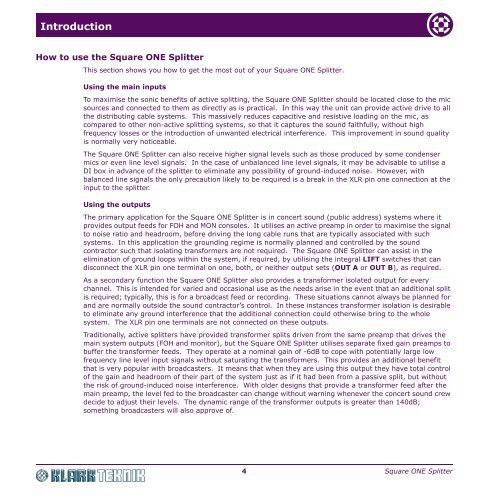Square ONE Splitter - manual_Issue B.book - Midas
Square ONE Splitter - manual_Issue B.book - Midas
Square ONE Splitter - manual_Issue B.book - Midas
Create successful ePaper yourself
Turn your PDF publications into a flip-book with our unique Google optimized e-Paper software.
Introduction<br />
How to use the <strong>Square</strong> <strong>ONE</strong> <strong>Splitter</strong><br />
This section shows you how to get the most out of your <strong>Square</strong> <strong>ONE</strong> <strong>Splitter</strong>.<br />
Using the main inputs<br />
To maximise the sonic benefits of active splitting, the <strong>Square</strong> <strong>ONE</strong> <strong>Splitter</strong> should be located close to the mic<br />
sources and connected to them as directly as is practical. In this way the unit can provide active drive to all<br />
the distributing cable systems. This massively reduces capacitive and resistive loading on the mic, as<br />
compared to other non-active splitting systems, so that it captures the sound faithfully, without high<br />
frequency losses or the introduction of unwanted electrical interference. This improvement in sound quality<br />
is normally very noticeable.<br />
The <strong>Square</strong> <strong>ONE</strong> <strong>Splitter</strong> can also receive higher signal levels such as those produced by some condenser<br />
mics or even line level signals. In the case of unbalanced line level signals, it may be advisable to utilise a<br />
DI box in advance of the splitter to eliminate any possibility of ground-induced noise. However, with<br />
balanced line signals the only precaution likely to be required is a break in the XLR pin one connection at the<br />
input to the splitter.<br />
Using the outputs<br />
The primary application for the <strong>Square</strong> <strong>ONE</strong> <strong>Splitter</strong> is in concert sound (public address) systems where it<br />
provides output feeds for FOH and MON consoles. It utilises an active preamp in order to maximise the signal<br />
to noise ratio and headroom, before driving the long cable runs that are typically associated with such<br />
systems. In this application the grounding regime is normally planned and controlled by the sound<br />
contractor such that isolating transformers are not required. The <strong>Square</strong> <strong>ONE</strong> <strong>Splitter</strong> can assist in the<br />
elimination of ground loops within the system, if required, by utilising the integral LIFT switches that can<br />
disconnect the XLR pin one terminal on one, both, or neither output sets (OUT A or OUT B), as required.<br />
As a secondary function the <strong>Square</strong> <strong>ONE</strong> <strong>Splitter</strong> also provides a transformer isolated output for every<br />
channel. This is intended for varied and occasional use as the needs arise in the event that an additional split<br />
is required; typically, this is for a broadcast feed or recording. These situations cannot always be planned for<br />
and are normally outside the sound contractor’s control. In these instances transformer isolation is desirable<br />
to eliminate any ground interference that the additional connection could otherwise bring to the whole<br />
system. The XLR pin one terminals are not connected on these outputs.<br />
Traditionally, active splitters have provided transformer splits driven from the same preamp that drives the<br />
main system outputs (FOH and monitor), but the <strong>Square</strong> <strong>ONE</strong> <strong>Splitter</strong> utilises separate fixed gain preamps to<br />
buffer the transformer feeds. They operate at a nominal gain of -6dB to cope with potentially large low<br />
frequency line level input signals without saturating the transformers. This provides an additional benefit<br />
that is very popular with broadcasters. It means that when they are using this output they have total control<br />
of the gain and headroom of their part of the system just as if it had been from a passive split, but without<br />
the risk of ground-induced noise interference. With older designs that provide a transformer feed after the<br />
main preamp, the level fed to the broadcaster can change without warning whenever the concert sound crew<br />
decide to adjust their levels. The dynamic range of the transformer outputs is greater than 140dB;<br />
something broadcasters will also approve of.<br />
4 <strong>Square</strong> <strong>ONE</strong> <strong>Splitter</strong>


